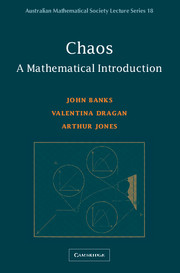Book contents
- Frontmatter
- Contents
- Preface
- 1 Making predictions
- 2 Mappings and orbits
- 3 Periodic orbits
- 4 Asymptotic orbits I: linear and affine mappings
- 5 Asymptotic orbits II: differentiable mappings
- 6 Families of mappings and bifurcations
- 7 Graphical composition, wiggly iterates and zeroes
- 8 Sensitive dependence
- 9 Ingredients of chaos
- 10 Schwarzian derivatives and ‘woggles’
- 11 Changing coordinates
- 12 Conjugacy
- 13 Wiggly iterates, Cantor sets and chaos
- Index
3 - Periodic orbits
Published online by Cambridge University Press: 05 June 2012
- Frontmatter
- Contents
- Preface
- 1 Making predictions
- 2 Mappings and orbits
- 3 Periodic orbits
- 4 Asymptotic orbits I: linear and affine mappings
- 5 Asymptotic orbits II: differentiable mappings
- 6 Families of mappings and bifurcations
- 7 Graphical composition, wiggly iterates and zeroes
- 8 Sensitive dependence
- 9 Ingredients of chaos
- 10 Schwarzian derivatives and ‘woggles’
- 11 Changing coordinates
- 12 Conjugacy
- 13 Wiggly iterates, Cantor sets and chaos
- Index
Summary
Everyday life is governed by periodic processes. For example, we may catch the bus at the same time each morning or watch the news on TV at the same time every evening. In nature, species of migratory birds return to their breeding ground at the same time every year. In the physical world the sun rises and sets with reassuring regularity, while the tide ebbs and flows at regular intervals of time.
In Dynamical Systems the concept which corresponds to periodic processes is that of a periodic orbit. Recall that an orbit of a mapping is a sequence of elements from its domain. The orbit is said to be periodic if it consists of a block of n elements repeated indefinitely. The positive integer n is called a period of the orbit.
The simplest type of periodic orbit is one which has period one. Such an orbit consists of the same element repeated indefinitely.
The behaviour of a periodic orbit of period n is known for all time once we know the first n elements of the orbit. Thus the behaviour of a periodic orbit might seem to be regular and predictable. It is therefore surprising that periodic behaviour can occur alongside behaviour which is chaotic, as we show later.
FIXED POINTS AND PERIODIC POINTS
Definition Let S be a set and let f : S → S be a mapping.
- Type
- Chapter
- Information
- Chaos: A Mathematical Introduction , pp. 45 - 60Publisher: Cambridge University PressPrint publication year: 2003

